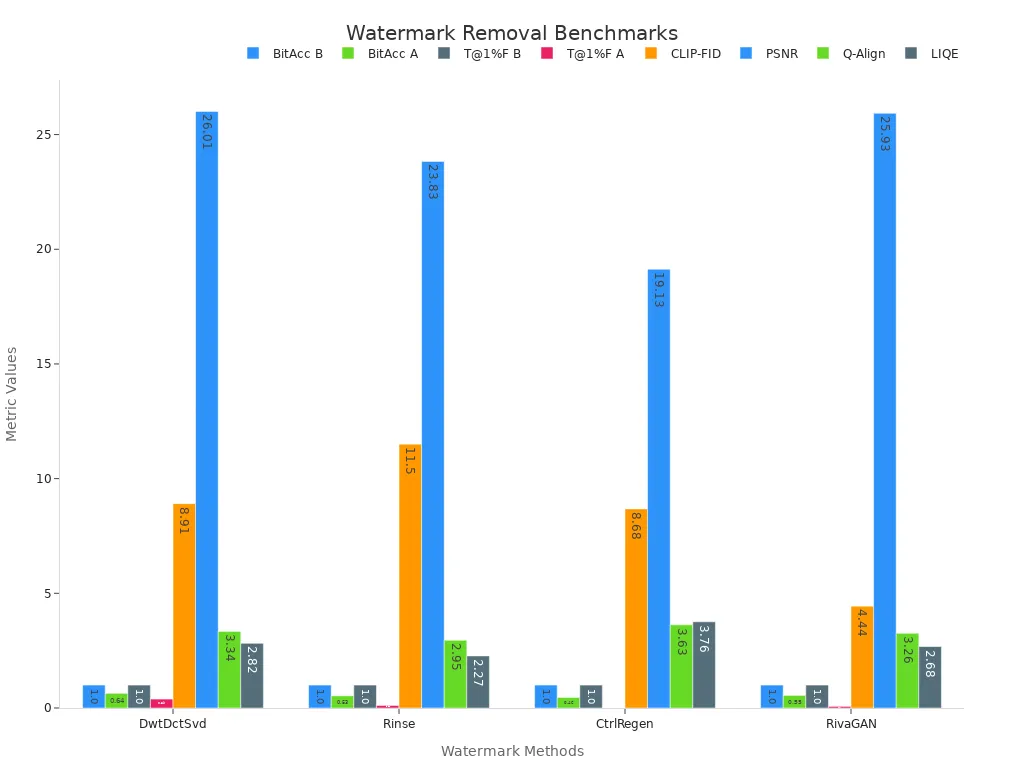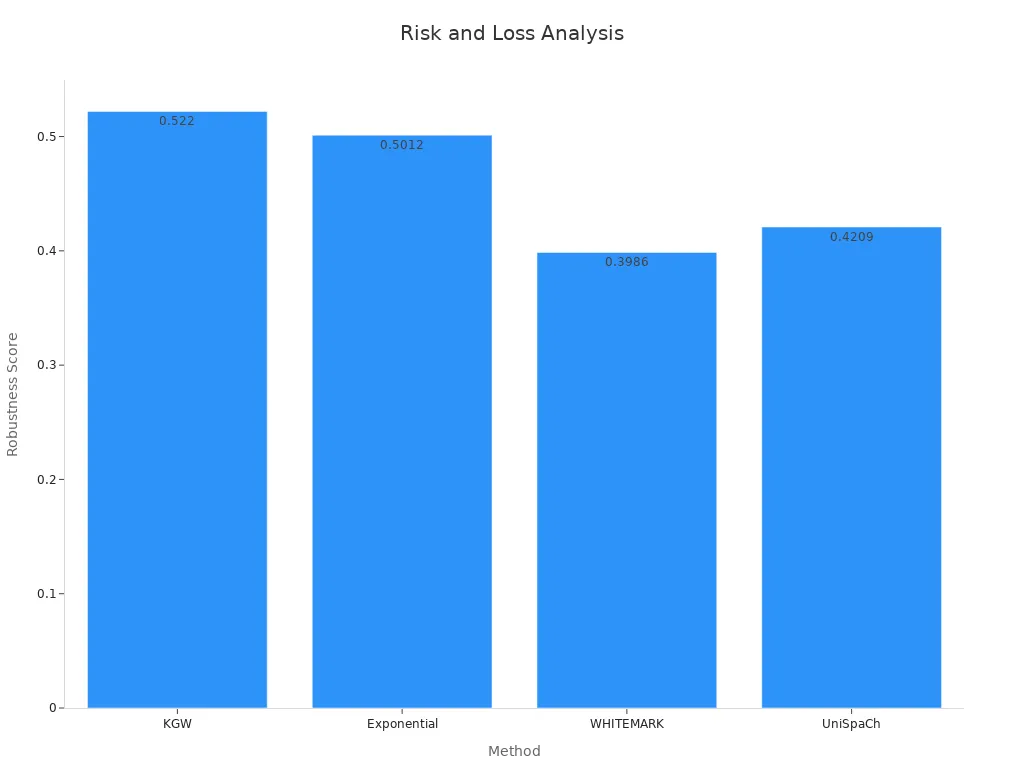A Deep Dive into Different Types of Image Watermarks and How to Remove Them

Have you ever noticed logos, text, or patterns on photos and wondered why they’re there? These are called watermarks. They serve as a way to protect copyright, ensuring that creators retain ownership of their work. Watermarking your works also helps with branding, making your photos instantly recognizable.
In our article, "A Deep Dive into Different Image Watermark Types and How to Remove Them," we explore the various types of watermarks you might encounter. But what if you need a clean image for personal use or editing? Maybe you’re working on a project and want to adjust the photo without distractions. While removing a watermark might seem simple, it’s crucial to respect copyright and avoid any copyright violation. Always consider whether you have permission before making changes.
Key Takeaways
Watermarks show who owns an image and protect creators' rights. Always follow copyright rules when using or changing images.
Visible watermarks, like words or logos, are easy to see. They stop people from using images without permission. Semi-clear designs look nice and still protect images.
Invisible watermarks are hidden in pictures and need special tools to find. They help check if an image is real and track its use.
Before removing watermarks, think about what is right. Always ask the owner for permission to avoid breaking copyright laws.
Tools like WatermarkGONE can remove watermarks quickly and keep the image looking good. They save time and give great results.
Types of Watermarks

When it comes to watermarking, there are several types you might encounter. Each serves a unique purpose, whether it's protecting copyright, tracking usage, or verifying authenticity. Let’s break them down so you can understand their differences.
Visible Watermarks
Visible watermarks are the most common type you’ll see. They’re intentionally placed on an image to make it clear who owns it. These watermarks often include text, logos, or even QR codes. You’ve probably noticed them on stock photos or professional images.
Here’s why visible watermarks are widely used:
They act as a deterrent against unauthorized use.
They clearly signal ownership, reducing the chances of illegal distribution.
They’re easy to create and apply, making them a go-to choice for photographers and content creators.
Tip: If you’re watermarking your own images, consider using semi-transparent text or logos. This keeps your watermark noticeable without overwhelming the image.
Visible watermarks are a great way to protect your work, but they can also be distracting if you’re trying to use the image for personal or professional projects.
Invisible Watermarks
Invisible watermarks are a bit more advanced. Unlike visible watermarks, these are hidden within the image and can’t be seen with the naked eye. They require specialized software to detect.
Here’s how invisible watermarks work:
Error-Correcting Codes (ECC): These allow the watermark to remain detectable even if the image is altered.
Semantic-Level Watermarking: This embeds patterns in the image’s underlying structure, making it harder to remove.
Statistical Fingerprints: These subtly modify elements like pixel distribution, creating a hidden signature that algorithms can recognize.
Invisible watermarks are often used for tracking and monitoring. For example, companies might use them to verify the authenticity of their digital assets or to trace the source of unauthorized copies.
Note: While invisible watermarks are harder to detect and remove, they’re not foolproof. Advanced editing tools can sometimes disrupt them.
Other Types of Digital Watermarks
Beyond visible and invisible watermarks, there are other types of digital watermarks designed for specific applications. Here’s a quick overview:
Type | Description |
|---|---|
Robust Watermarks | Designed to withstand editing or compression, ensuring the watermark remains intact. |
Fragile Watermarks | Sensitive to changes, making them ideal for detecting tampering. |
Public Watermarks | Use public keys for verification, but they’re less secure than private watermarks. |
Private Watermarks | Use secret keys, offering higher security for sensitive applications. |
Spatial Domain | Modify pixel values directly, making them simple but less resistant to attacks. |
Frequency Domain | Embed watermarks in frequency coefficients, offering better resistance to image processing. |
These types of digital watermarking techniques are tailored to different needs, from copyright protection to tamper detection. For instance, robust watermarks are perfect for applications where the image might undergo heavy editing, while fragile watermarks are ideal for verifying the integrity of sensitive documents.
Understanding the types of watermarks and their applications can help you choose the right method for your needs. Whether you’re protecting your work or trying to remove a watermark, knowing how they function is the first step.
Characteristics of Visible Watermarks
Visible watermarks are the most recognizable types of photo watermarks. They’re designed to stand out, making it clear who owns the image. Let’s explore the different forms they take and how they work.
Text-Based Watermarks

Image Source: Getty Images
Text watermarks are one of the simplest and most common types of photo watermarks. You’ve probably seen them on stock images or professional photos. They usually include the creator’s name, website, or copyright notice.
Why are text watermarks so popular?
They’re easy to create and customize.
They can be placed anywhere on the image.
They’re effective at discouraging unauthorized use.
If you’re adding a text watermark to your own images, think about placement. A watermark in the corner might be less intrusive, but one in the center is harder to crop out. Balancing visibility and subtlety is key.
Logo Overlays

Logo watermarks are another popular choice, especially for businesses and brands. These watermarks feature a company’s logo, making them ideal for branding. You’ll often see them on promotional images, product photos, or social media posts.
Using a logo watermark has its perks:
It reinforces brand identity.
It makes your images instantly recognizable.
It adds a professional touch to your visuals.
When designing a logo watermark, keep it simple. A clean, minimal design ensures it doesn’t overpower the image. After all, you want the focus to remain on the photo itself.
Semi-Transparent Watermarks

Semi-transparent watermarks strike a balance between protection and aesthetics. They’re visible enough to deter unauthorized use but subtle enough not to ruin the image. This makes them a favorite for commercial digital images.
Here’s why semi-transparent watermarks work so well:
They protect product images from being misused.
They maintain the image’s quality and appeal.
They’re noticeable without being distracting.
To create an effective semi-transparent watermark, adjust the opacity. A watermark that’s too bold can overshadow the photo, while one that’s too faint might go unnoticed. Striking the right balance ensures your image stays both protected and visually appealing.
Visible watermarks, whether they’re text watermarks, logo watermarks, or semi-transparent designs, offer a practical way to safeguard your work. By understanding their characteristics, you can choose the best option for your needs.
Characteristics of Invisible Watermarks

Invisible watermarks are like hidden signatures embedded in your images. They’re designed to protect intellectual property without altering the visual appeal of the photo. Let’s explore three key types of invisible watermarks and how they work.
Fragile Watermarks
Fragile watermarks are highly sensitive to changes. Even minor edits, like cropping or adding noise, can disrupt them. These watermarks are perfect for detecting tampering or verifying the integrity of an image. For example, they’re often used in official documents or facial recognition systems to ensure authenticity.
Researchers have developed advanced methods to enhance the resilience of fragile watermarks. A feasibility assessment shows that deep steganographic embedding can verify the integrity of ICAO-compliant facial images. Another study uses a classification model to identify alterations, such as morphing or compression artifacts, based on their impact on the watermark.
Contribution | Description |
|---|---|
Feasibility Assessment | Evaluates fragile watermarking via deep steganographic embedding for integrity verification of ICAO-compliant facial images. |
Classification Model | Develops a model to distinguish between types of alterations (e.g., morphing, compression artifacts, noise addition) based on their impact on the retrieved marker. |
Fragile watermarks act as silent guardians, ensuring your images remain untouched and trustworthy.
Robust Watermarks
Robust watermarks are built to withstand the storm. They’re designed to stay intact even when an image undergoes significant changes, like cropping, compression, or collage attacks. These watermarks are ideal for applications where images might face heavy editing or tampering.
The strength of robust watermarking lies in its use of discrete wavelet transform (DWT). This technique embeds watermarks by generating recovery and authentication bits from the most significant bits of transformed coefficients. It’s highly effective against various attacks, maintaining a watermark capacity of 13 bits per block and localizing tampered regions even when attack severity reaches 62.5%.
With robust watermarks, you can protect your images without worrying about losing their integrity during edits.
Forensic Watermarks
Forensic watermarks take protection to the next level. They’re designed to trace the source of unauthorized copies or leaks. These watermarks embed unique identifiers into the image, allowing you to track its journey across digital platforms.
Imagine you’re a photographer sharing your work online. Forensic watermarks can help you identify if someone has distributed your image without permission. They’re widely used in industries like media and entertainment to safeguard sensitive content.
These invisible watermarks offer a powerful way to monitor and protect your digital assets, ensuring your work remains secure.
Invisible watermarks, whether fragile, robust, or forensic, provide a sophisticated layer of protection for your images. By understanding their characteristics, you can choose the right type to meet your needs.
How to Remove Watermarks
Removing watermarks can be tricky, but it’s not impossible. Whether you’re working on a personal project or need a clean image for professional use, there are several ways to tackle this task. Let’s explore both manual and automated methods, along with the challenges you might face.
Manual Methods for Watermark Removal

If you’re up for a hands-on approach, manual methods can help you remove watermarks with precision. These techniques require some effort and basic editing skills, but they’re effective for simple watermarks.
Here are a few common manual methods:
Cloning and Healing Tools: Most photo editing software, like Photoshop or GIMP, offers cloning and healing tools. You can use these to copy pixels from surrounding areas and cover the watermark.
Cropping: If the watermark is located near the edges of the image, cropping it out might be the easiest solution. However, this method sacrifices part of the image.
Painting Over: For watermarks on plain backgrounds, you can paint over them using a color that matches the surrounding area.
Tip: When using manual methods, pay attention to details. A poorly edited area can make the image look unnatural.
Manual methods work best for simple watermarks, like text or small logos. But they can be time-consuming and may not deliver perfect results for complex or semi-transparent watermarks.
Automated Tools for Watermark Removal

If manual editing feels overwhelming, automated tools can save the day. These tools use advanced algorithms to detect and remove watermarks with minimal effort on your part. One standout option is WatermarkGONE, an AI-powered tool designed to handle all types of watermarks, from text overlays to intricate logos.
Here’s why automated tools are a game-changer:
Speed: Automated tools can process images in seconds, saving you valuable time.
Precision: AI-powered tools like WatermarkGONE analyze the image and remove watermarks without affecting its quality.
Batch Processing: Need to remove watermarks from multiple images? Automated tools can handle bulk tasks effortlessly.
Empirical studies have shown the effectiveness of automated methods. For instance:
The MorphoMod method combines morphological dilation and inpainting to remove watermarks. It delivers high-quality results with low error rates.
Performance evaluations of state-of-the-art models reveal that pre-removal filling strategies significantly impact the final output.
Watermarks | Attacks | BitAcc B | BitAcc A | T@1%F B | T@1%F A | CLIP-FID | PSNR | Q-Align | LIQE |
|---|---|---|---|---|---|---|---|---|---|
DwtDctSvd | Regen | 1.00 | 0.64 | 1.00 | 0.39 | 8.91 | 26.01 | 3.34 | 2.82 |
Rinse | 1.00 | 0.53 | 1.00 | 0.11 | 11.50 | 23.83 | 2.95 | 2.27 | |
CtrlRegen | 1.00 | 0.46 | 1.00 | 0.00 | 8.68 | 19.13 | 3.63 | 3.76 | |
RivaGAN | Regen | 1.00 | 0.55 | 1.00 | 0.07 | 4.44 | 25.93 | 3.26 | 2.68 |

Automated tools are ideal for complex watermarks or when you need consistent results across multiple images. They’re fast, efficient, and user-friendly.
Challenges and Risks in Watermark Removal
While removing watermarks might seem straightforward, it comes with its own set of challenges and risks. Understanding these can help you avoid potential pitfalls.
Common Challenges:
Complex Watermarks: Semi-transparent or multi-layered watermarks are harder to remove without affecting the image quality.
Loss of Detail: Aggressive editing can distort the image, making it look unnatural.
Time-Consuming: Manual methods, in particular, can take hours for a single image.
Risks to Consider:
Ethical Concerns: Removing a watermark without permission can violate copyright laws. Always ensure you have the right to edit the image.
Accuracy Degradation: Some methods may compromise the image’s accuracy. For example, robustness scores for certain watermarking schemes, like KGW and Exponential, show vulnerabilities to attacks.
Method | Robustness Score | Accuracy Degradation |
|---|---|---|
KGW | 0.5220 | < 6% |
Exponential | 0.5012 | < 6% |
WHITEMARK | 0.3986 | < 6% |
UniSpaCh | 0.4209 | < 6% |

Note: Pre-text watermarks are generally more imperceptible but can still be vulnerable to post-text attacks.
Removing watermarks requires a careful approach. Whether you’re using manual or automated methods, always weigh the risks and ensure you’re respecting intellectual property rights.
Why WatermarkGONE is the Ideal Tool for Removing All Types of Watermarks
When it comes to removing watermarks, you need a tool that’s fast, accurate, and versatile. That’s where WatermarkGONE shines. Powered by cutting-edge AI, it’s designed to handle all types of watermarking challenges effortlessly. Let’s dive into what makes it the ultimate solution.
AI Precision for Accurate Watermark Removal
WatermarkGONE uses advanced AI technology to deliver unmatched precision. Its intelligent algorithms analyze your image, detect watermarks, and remove them seamlessly without compromising quality. Whether it’s a text overlay, a logo, or a semi-transparent design, the tool ensures flawless results every time.
Here’s a closer look at the technological advancements behind its accuracy:
Feature | Improvement |
|---|---|
Processing Speed | |
Cost-Effectiveness | Up to 85% more cost-effective |
Dataset Size | Trained on over 5 million images |
Unique Watermark Styles | 30,000+ unique styles |
Detection Mechanism | Early detection for better accuracy |
Reconstruction Technique | Adaptive reconstruction for seamless inpainting |

This level of precision means you can trust WatermarkGONE to handle even the most complex watermarking scenarios with ease.
Versatility for Removing Different Types of Watermarks
Not all watermarks are created equal, and that’s why versatility matters. WatermarkGONE is equipped to tackle a wide range of watermarking styles, from visible text and logos to semi-transparent watermarks. Its adaptability ensures that no matter the type of watermark, you’ll get a clean, professional-looking image.
The tool’s ability to handle over 30,000 unique watermark styles speaks volumes about its flexibility. Whether you’re dealing with fragile watermarks on sensitive documents or robust ones on high-resolution images, WatermarkGONE has you covered.
Tip: If you’re unsure about the type of watermark on your image, let WatermarkGONE’s AI do the heavy lifting. It automatically identifies and removes watermarks without requiring any technical input from you.
Batch Processing for Efficient Watermark Removal
If you’ve got a large set of images to process, WatermarkGONE’s batch processing feature will save you hours of work. This capability allows you to remove watermarks from multiple images simultaneously, making it perfect for photographers, marketers, and content creators.
Here’s what makes its batch processing so efficient:
70% Faster Processing: Achieved through multi-GPU training and optimized loss functions.
85% More Cost-Effective: Thanks to a unified workflow that reduces unnecessary computations.
5 million real-world images used for training, ensuring high accuracy.
30,000+ unique watermark styles handled effortlessly.
With WatermarkGONE, you can focus on your creative projects while the tool takes care of the heavy lifting. It’s like having a personal assistant for your watermarking needs.
WatermarkGONE combines precision, versatility, and efficiency to deliver a seamless experience. Whether you’re working on a single image or an entire portfolio, this tool ensures your visuals are watermark-free and ready to shine.
Watermarks play a vital role in protecting intellectual property and showcasing ownership. From visible watermarks like text and logos to invisible ones embedded within images, each type has unique characteristics. Here’s a quick recap:
Type of Watermark | Characteristics | Pros | Cons |
|---|---|---|---|
Visible Watermarks | Easily noticeable; includes logos, text, or patterns. | Clear ownership information; customizable. | Can be cropped or erased; may distract. |
- Text Watermarks | Consists of copyright notices, names, or branding messages. | Easy to create; good for branding. | Can be distracting; easy to remove. |
- Logo Watermarks | Includes a brand’s logo, placed strategically. | Strengthens brand identity; looks professional. | May require design adjustments; can distract. |
- Pattern/Full-Image | Repeating pattern or semi-transparent design across the image. | Extremely difficult to remove; maximum security. | Reduces visibility; not ideal for marketing. |
Invisible Watermarks | Embedded within an image, not detectable to the human eye. | Does not interfere with aesthetics; harder to remove. | Requires special tools; may not deter theft. |
When removing a watermark, always act responsibly. Respect the creator’s rights and avoid unauthorized use. Tools like WatermarkGONE make the process seamless while preserving image quality. Its AI-powered precision and batch processing capabilities ensure you get professional results without compromising ethics.
Remember, using watermark removal tools responsibly isn’t just about legality—it’s about respecting creativity and effort.
FAQ
What are watermarks, and why are they used?
Watermarks are marks, like text or logos, placed on images to show ownership or protect intellectual property. They help prevent unauthorized use and ensure creators get credit for their work. You’ll often see them on stock photos or professional visuals.
Can all types of watermarks be removed?
Yes, but the difficulty depends on the type. Visible watermarks, like text or logos, are easier to remove. Invisible ones, embedded within the image, require advanced tools. Always ensure you have permission before attempting removal.
Is it legal to remove watermarks from images?
It depends. Removing watermarks without the creator’s consent can violate copyright laws. Always check the image’s usage rights or get permission from the owner before making changes.
How does WatermarkGONE handle watermark removal?
WatermarkGONE uses AI to detect and remove watermarks with precision. It works on all types, including text overlays, logos, and semi-transparent designs. The tool ensures your image quality stays intact while saving you time with batch processing.
See Also
Effective Strategies for Eliminating Watermarks from Getty Images
Best Five Online Resources for Watermark Removal in 2025
Common Errors to Steer Clear of When Removing Watermarks
Methods to Eliminate Transparent Watermarks Without Blurring Backgrounds

